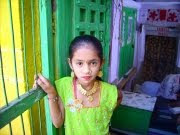 This shelter offers sloth bears, rescued from being performing animals, a chance to live without constant pain, says ADELINE BERTIN
This shelter offers sloth bears, rescued from being performing animals, a chance to live without constant pain, says ADELINE BERTINThe sight might not be as commonplace as it once was, but it’s a familiar image in small towns and villages across most of the country: sloth bears being made to dance for the delectation of a motley audience, which is then asked to ante up for the show.
What the bug-eyed audience doesn’t know — and the kalandars, members of a nomadic community that often works with animals, do not want tourists and viewers to ever see — is what lies behind the piece of leather that covers the bear’s snout. The bear isn’t really dancing: a red-hot iron needle has been thrust into its nose, and a rope threaded through it. Since the wound never has a chance to heal, when the rope is pulled, the bear rears in pain — and that’s the dance.
After the government banned dancing bears in 1998, activists Geeta Seshamani (Delhites know of her from Friendicoes, the dog shelter she co-founded there 30 years ago) and Kartick Satyanarayan, founders of Wildlife SOS, established the Agra Bear Rescue Facility in 2000. This was done with the help of the Uttar Pradesh Forest Department, to try and bring an end to the 400 years old practice of dancing bears in India.
Rani was the first bear to come into the facility in December 2002. Since then, the rescue centre has grown, and now it’s the biggest bear centre in the world, with a total area of 160 acres,270 bears and about 70 staff. The idea is to provide the bears with medical treatment and care. “The way we treat, socialise and rehabilitate them needs to be done keeping in mind their psychological trauma and their past,” explains Satyanarayan.
In the first three months, each bear undergoes a quarantine period, during which it’s vaccinated and given plenty of tonics and fruit to build up immunity levels. Then, the bear is moved to a large socialisation enclosure, where it can interact with others.
Unfortunately, the bears can never be completely rehabilitated — which means releasing them back into the wild because, as Satyanarayan points out, “their teeth have been knocked out and their claws removed to be sold as amulets”.
Of course, it isn’t enough to just bring in the bears: part of the rehab process is providing the kalandars with an with an alternative livelihood option, so that their incentive to trap bears and use them for dancing is reduced. So, part of WSOS’ demit has been to launch social welfare projects to help this marginalised community. “We did not expect we would end up doing this. But we are quite thrilled because when we look back, we see a huge success,” says Kartick.
Now, from one dancing bear sanctuary in Agra, WSOS has expanded to four sanctuaries. “In 1997, there were 1200 dancing bears in India; now, we only have about 95 to 200 such bears left,” says Satyanaryan happily. WSOS hopes to have brought in all of them by Christmas this year. If that goal is achieved, it will indeed be the perfect Christmas present— for the bears, and indeed, for India.

